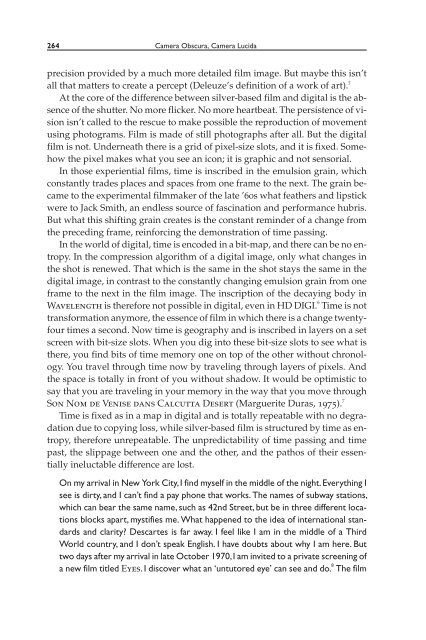Camera Obscura, Camera Lucida
Camera Obscura, Camera Lucida
Camera Obscura, Camera Lucida
You also want an ePaper? Increase the reach of your titles
YUMPU automatically turns print PDFs into web optimized ePapers that Google loves.
264 <strong>Camera</strong> <strong>Obscura</strong>, <strong>Camera</strong> <strong>Lucida</strong><br />
precision provided by a much more detailed film image. But maybe this isn’t<br />
all that matters to create a percept (Deleuze’s definition of a work of art). 5<br />
At the core of the difference between silver-based film and digital is the absence<br />
of the shutter. No more flicker. No more heartbeat. The persistence of vision<br />
isn’t called to the rescue to make possible the reproduction of movement<br />
using photograms. Film is made of still photographs after all. But the digital<br />
film is not. Underneath there is a grid of pixel-size slots, and it is fixed. Somehow<br />
the pixel makes what you see an icon; it is graphic and not sensorial.<br />
In those experiential films, time is inscribed in the emulsion grain, which<br />
constantly trades places and spaces from one frame to the next. The grain became<br />
to the experimental filmmaker of the late ’60s what feathers and lipstick<br />
were to Jack Smith, an endless source of fascination and performance hubris.<br />
But what this shifting grain creates is the constant reminder of a change from<br />
the preceding frame, reinforcing the demonstration of time passing.<br />
In the world of digital, time is encoded in a bit-map, and there can be no entropy.<br />
In the compression algorithm of a digital image, only what changes in<br />
the shot is renewed. That which is the same in the shot stays the same in the<br />
digital image, in contrast to the constantly changing emulsion grain from one<br />
frame to the next in the film image. The inscription of the decaying body in<br />
Wavelength is therefore not possible in digital, even in HD DIGI. 6 Time is not<br />
transformation anymore, the essence of film in which there is a change twentyfour<br />
times a second. Now time is geography and is inscribed in layers on a set<br />
screen with bit-size slots. When you dig into these bit-size slots to see what is<br />
there, you find bits of time memory one on top of the other without chronology.<br />
You travel through time now by traveling through layers of pixels. And<br />
the space is totally in front of you without shadow. It would be optimistic to<br />
say that you are traveling in your memory in the way that you move through<br />
Son Nom de Venise dans Calcutta Desert (Marguerite Duras, 1975). 7<br />
Time is fixed as in a map in digital and is totally repeatable with no degradation<br />
due to copying loss, while silver-based film is structured by time as entropy,<br />
therefore unrepeatable. The unpredictability of time passing and time<br />
past, the slippage between one and the other, and the pathos of their essentially<br />
ineluctable difference are lost.<br />
On my arrival in New York City,I find myself in the middle of the night.Everything I<br />
see is dirty, and I can’t find a pay phone that works. The names of subway stations,<br />
which can bear the same name, such as 42nd Street, but be in three different locations<br />
blocks apart, mystifies me. What happened to the idea of international standards<br />
and clarity? Descartes is far away. I feel like I am in the middle of a Third<br />
World country, and I don’t speak English. I have doubts about why I am here. But<br />
two days after my arrival in late October 1970,I am invited to a private screening of<br />
a new film titled Eyes. I discover what an ‘untutored eye’ can see and do. 8 The film






